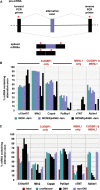Heart-specific overexpression of CUGBP1 reproduces functional and molecular abnormalities of myotonic dystrophy type 1
- PMID: 20051426
- PMCID: PMC2830830
- DOI: 10.1093/hmg/ddp570
Heart-specific overexpression of CUGBP1 reproduces functional and molecular abnormalities of myotonic dystrophy type 1
Abstract
Myotonic dystrophy type 1 (DM1) is caused by a CTG expansion within the 3'-untranslated region of the DMPK gene. The predominant mechanism of pathogenesis is a toxic gain of function of CUG repeat containing RNA transcribed from the expanded allele. The molecular mechanisms by which the RNA containing expanded repeats produce pathogenic effects include: sequestration of muscleblind-like 1 (MBNL1) protein and up-regulation of CUG binding protein 1 (CUGBP1). MBNL1 and CUGBP1 are RNA binding proteins that regulate alternative splicing transitions during development. Altered functions of these proteins in DM1 lead to misregulated splicing of their target genes, resulting in several features of the disease. The role of MBNL1 depletion in DM1 is well established through a mouse knock-out model that reproduces many disease features. Here we directly test the hypothesis that CUGBP1 up-regulation also contributes to manifestations of DM1. Using tetracycline-inducible CUGBP1 and heart-specific reverse tetracycline trans-activator transgenes, we expressed human CUGBP1 in adult mouse heart. Our results demonstrate that up-regulation of CUGBP1 is sufficient to reproduce molecular, histopathological and functional changes observed in a previously described DM1 mouse model that expresses expanded CUG RNA repeats as well as in individuals with DM1. These results strongly support a role for CUGBP1 up-regulation in DM1 pathogenesis.
Figures





Similar articles
-
CUGBP1 overexpression in mouse skeletal muscle reproduces features of myotonic dystrophy type 1.Hum Mol Genet. 2010 Sep 15;19(18):3614-22. doi: 10.1093/hmg/ddq277. Epub 2010 Jul 5. Hum Mol Genet. 2010. PMID: 20603324 Free PMC article.
-
Elevation of RNA-binding protein CUGBP1 is an early event in an inducible heart-specific mouse model of myotonic dystrophy.J Clin Invest. 2007 Oct;117(10):2802-11. doi: 10.1172/JCI32308. J Clin Invest. 2007. PMID: 17823658 Free PMC article.
-
PKC inhibition ameliorates the cardiac phenotype in a mouse model of myotonic dystrophy type 1.J Clin Invest. 2009 Dec;119(12):3797-806. doi: 10.1172/JCI37976. Epub 2009 Nov 9. J Clin Invest. 2009. PMID: 19907076 Free PMC article.
-
Pathogenic mechanisms of myotonic dystrophy.Biochem Soc Trans. 2009 Dec;37(Pt 6):1281-6. doi: 10.1042/BST0371281. Biochem Soc Trans. 2009. PMID: 19909263 Free PMC article. Review.
-
Correction of RNA-Binding Protein CUGBP1 and GSK3β Signaling as Therapeutic Approach for Congenital and Adult Myotonic Dystrophy Type 1.Int J Mol Sci. 2019 Dec 21;21(1):94. doi: 10.3390/ijms21010094. Int J Mol Sci. 2019. PMID: 31877772 Free PMC article. Review.
Cited by
-
CUG-BP, Elav-like family member 1 (CELF1) is required for normal myofibrillogenesis, morphogenesis, and contractile function in the embryonic heart.Dev Dyn. 2016 Aug;245(8):854-73. doi: 10.1002/dvdy.24413. Epub 2016 May 31. Dev Dyn. 2016. PMID: 27144987 Free PMC article.
-
Loss of muscleblind-like 1 results in cardiac pathology and persistence of embryonic splice isoforms.Sci Rep. 2015 Mar 12;5:9042. doi: 10.1038/srep09042. Sci Rep. 2015. PMID: 25761764 Free PMC article.
-
Modeling Myotonic Dystrophy 1 in C2C12 Myoblast Cells.J Vis Exp. 2016 Jul 29;(113):54078. doi: 10.3791/54078. J Vis Exp. 2016. PMID: 27501221 Free PMC article.
-
miR-322/-503 cluster is expressed in the earliest cardiac progenitor cells and drives cardiomyocyte specification.Proc Natl Acad Sci U S A. 2016 Aug 23;113(34):9551-6. doi: 10.1073/pnas.1608256113. Epub 2016 Aug 10. Proc Natl Acad Sci U S A. 2016. PMID: 27512039 Free PMC article.
-
Increased Muscleblind levels by chloroquine treatment improve myotonic dystrophy type 1 phenotypes in in vitro and in vivo models.Proc Natl Acad Sci U S A. 2019 Dec 10;116(50):25203-25213. doi: 10.1073/pnas.1820297116. Epub 2019 Nov 21. Proc Natl Acad Sci U S A. 2019. PMID: 31754023 Free PMC article.
References
-
- Harper P.S. Myotonic Dystrophy. London: W.B. Saunders; 2001.
-
- Liquori C.L., Ricker K., Moseley M.L., Jacobsen J.F., Kress W., Naylor S.L., Day J.W., Ranum L.P. Myotonic dystrophy type 2 caused by a CCTG expansion in intron 1 of ZNF9. Science. 2001;293:864–867. - PubMed
-
- Bushby K., Muntoni F., Bourke J.P. 107th ENMC international workshop: the management of cardiac involvement in muscular dystrophy and myotonic dystrophy. 7th–9th June 2002, Naarden, the Netherlands. Neuromuscul. Disord. 2003;13:166–172. - PubMed
-
- Schara U., Schoser B.G. Myotonic dystrophies type 1 and 2: a summary on current aspects. Semin. Pediatr. Neurol. 2006;13:71–79. - PubMed
-
- Groh W.J., Groh M.R., Saha C., Kincaid J.C., Simmons Z., Ciafaloni E., Pourmand R., Otten R.F., Bhakta D., Nair G.V., et al. Electrocardiographic abnormalities and sudden death in myotonic dystrophy type 1. N. Engl. J. Med. 2008;358:2688–2697. - PubMed
Publication types
MeSH terms
Substances
Grants and funding
LinkOut - more resources
Full Text Sources
Other Literature Sources
Medical
Molecular Biology Databases
Research Materials

